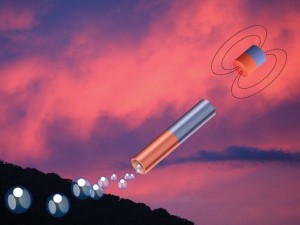A collaboration between scientists in Germany and Singapore has produced a micromotor that can be controlled by a magnetic field.
The motors are microtubes that contain a platinum catalyst and iron. The catalyst reacts with hydrogen peroxide to produce a jet of oxygen bubbles to drive the tube forward and the iron allows the tubes to react to a magnet. Gaining control of the direction in which the tubes travel is the challenge, and now scientists have found a way to manipulate the direction using magnets. This is a step towards a future in which they could be used inside the body, as engines in nanoscale systems or for environmental remediation.
Martin Pumera, who is based at Nanyang Technological University, Singapore, and his team, worked with researchers from the Leibniz Institute for Solid State and Materials Research Dresden, Germany, to make the micromotors. First they deposited thin layers of titanium, iron, chromium and platinum on a support. Once the support was removed, the layers rolled into a tube. Next, the microtubes were made into permanent magnets, using a neodymium magnet, and put into a hydrogen peroxide solution to test their reaction to external magnets.
Read the full article in Chemistry World
Link to journal article
Micromotors with built-in compasses
G Zhao et al
Chem. Commun., 2012, DOI: 10.1039/c2cc35671f











